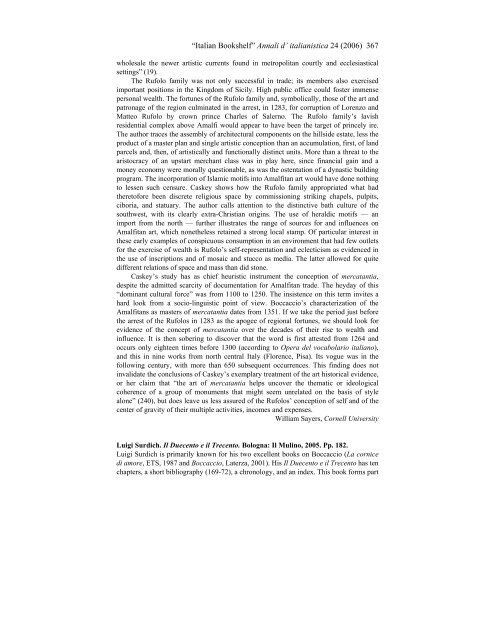364 Italian Bookshelf - Ibiblio
364 Italian Bookshelf - Ibiblio
364 Italian Bookshelf - Ibiblio
You also want an ePaper? Increase the reach of your titles
YUMPU automatically turns print PDFs into web optimized ePapers that Google loves.
“<strong>Italian</strong> <strong>Bookshelf</strong>” Annali d’ italianistica 24 (2006) 367<br />
wholesale the newer artistic currents found in metropolitan courtly and ecclesiastical<br />
settings” (19).<br />
The Rufolo family was not only successful in trade; its members also exercised<br />
important positions in the Kingdom of Sicily. High public office could foster immense<br />
personal wealth. The fortunes of the Rufolo family and, symbolically, those of the art and<br />
patronage of the region culminated in the arrest, in 1283, for corruption of Lorenzo and<br />
Matteo Rufolo by crown prince Charles of Salerno. The Rufolo family’s lavish<br />
residential complex above Amalfi would appear to have been the target of princely ire.<br />
The author traces the assembly of architectural components on the hillside estate, less the<br />
product of a master plan and single artistic conception than an accumulation, first, of land<br />
parcels and, then, of artistically and functionally distinct units. More than a threat to the<br />
aristocracy of an upstart merchant class was in play here, since financial gain and a<br />
money economy were morally questionable, as was the ostentation of a dynastic building<br />
program. The incorporation of Islamic motifs into Amalfitan art would have done nothing<br />
to lessen such censure. Caskey shows how the Rufolo family appropriated what had<br />
theretofore been discrete religious space by commissioning striking chapels, pulpits,<br />
ciboria, and statuary. The author calls attention to the distinctive bath culture of the<br />
southwest, with its clearly extra-Christian origins. The use of heraldic motifs — an<br />
import from the north — further illustrates the range of sources for and influences on<br />
Amalfitan art, which nonetheless retained a strong local stamp. Of particular interest in<br />
these early examples of conspicuous consumption in an environment that had few outlets<br />
for the exercise of wealth is Rufolo’s self-representation and eclecticism as evidenced in<br />
the use of inscriptions and of mosaic and stucco as media. The latter allowed for quite<br />
different relations of space and mass than did stone.<br />
Caskey’s study has as chief heuristic instrument the conception of mercatantia,<br />
despite the admitted scarcity of documentation for Amalfitan trade. The heyday of this<br />
“dominant cultural force” was from 1100 to 1250. The insistence on this term invites a<br />
hard look from a socio-linguistic point of view. Boccaccio’s characterization of the<br />
Amalfitans as masters of mercatantia dates from 1351. If we take the period just before<br />
the arrest of the Rufolos in 1283 as the apogee of regional fortunes, we should look for<br />
evidence of the concept of mercatantia over the decades of their rise to wealth and<br />
influence. It is then sobering to discover that the word is first attested from 1264 and<br />
occurs only eighteen times before 1300 (according to Opera del vocabolario italiano),<br />
and this in nine works from north central Italy (Florence, Pisa). Its vogue was in the<br />
following century, with more than 650 subsequent occurrences. This finding does not<br />
invalidate the conclusions of Caskey’s exemplary treatment of the art historical evidence,<br />
or her claim that “the art of mercatantia helps uncover the thematic or ideological<br />
coherence of a group of monuments that might seem unrelated on the basis of style<br />
alone” (240), but does leave us less assured of the Rufolos’ conception of self and of the<br />
center of gravity of their multiple activities, incomes and expenses.<br />
William Sayers, Cornell University<br />
Luigi Surdich. Il Duecento e il Trecento. Bologna: Il Mulino, 2005. Pp. 182.<br />
Luigi Surdich is primarily known for his two excellent books on Boccaccio (La cornice<br />
di amore, ETS, 1987 and Boccaccio, Laterza, 2001). His Il Duecento e il Trecento has ten<br />
chapters, a short bibliography (169-72), a chronology, and an index. This book forms part

















